
Newsletter of the Shell Club of Sydney
NSW Branch, The Malacological Society of Australasia Limited ACN 067 894 848
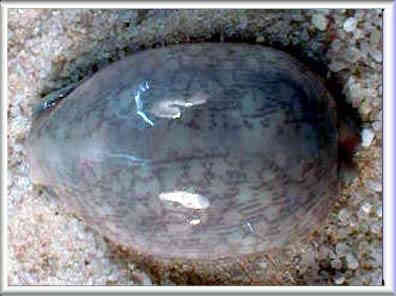
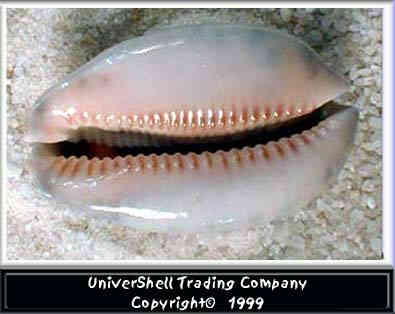
Unusual coloured Cypraea arabica from the Philippines after the eruption of a volcano. The poor shell lived on in waters rich in volcanic ash and the ash
colouring became incorporated into the cowrie's shell.
The Universal Shell Trading Company has many interesting specimens in its picture galleries.
www.univershell.com Photos by rjnjr using a digital camera.
A Sheller's Creed
Excerpt From the 'Internet Hawaiian Shell News'
The wild life and natural resources of this world have been entrusted to me for protection and preservation. Whether I wish it or not, I must account to the future for my handling of this wealth today.
If I collect shells, I will do it conservatively, recognizing that destruction of the marine habitat, by whatever means, is the true enemy of the sea and its creatures.
Four rules to shell by
1 Leave the live coral heads alone! Look in the rubble, under the slabs, in the sand and among the loose chunks.
2 Put rocks and corals back in place, the way you found them, even in deep water. Many things live under them even if you do not recognize them. Continued exposure to light and current will kill many of them.
3 Be alert for shell eggs and protect them. They have a slim chance of survival, at best. Don't take the mollusc that is guarding them. Avoid disturbing breeding groups.
4 Collect only what you really need. Take time to examine your finds and leave them to grow and breed if they do not really meet your needs.

The Marine & Coastal Community Network has a web site. www.ozemail.com.au/~mccnet/
(Every few months issues of this organization's newsletter are handed out at our club
meetings). The web site includes back issues of the newsletters, newsletters of other states, general information, upcoming events, information sheets and links to other related sites. Below is an interesting excerpt from the general section of this site about Australia, followed by an information sheet on Pilot Whales. Elsewhere in this Sheller is information about the upcoming 'Talk Fest on Bass Strait'
Australia's Ocean
Australia's waters span almost 60 degrees in latitude from Torres Strait in the north to Antarctica in the south, and 100 degrees in longitude from Norfolk Island in the east to Heard and Macdonald Islands in the west.
Australia recently developed a national Oceans Policy to assist the Australian government manage this vast area.
Australia's ocean includes all of the world's five temperature zones: tropical, subtropical, temperate, subpolar and polar. The mainland is surrounded by a physical continental shelf between 15 and 400 kilometres wide, and approximately 2.5 million square kilometres in area. The Australian Exclusive Economic Zone (EEZ) and the extensions of the continental shelf contain major physical features that rival those of the continent itself. Fields of seamounts to the south of Tasmania contain peaks rising 2-3 times the height of our highest terrestrial peaks.
Australia's marine environment contains some of the most diverse, unique and spectacular marine life in the world. Our waters contain some of the world's most diverse fish fauna, with over 4000 fish and 166 shark species. The reefs of northern Australia contain more than 500 species of coral and Australia boasts 30 of the world's 58 species of seagrass.
Australia's marine based industries are of importance economically. In 1994 they were valued at approximately $30 billion. Marine based industries are a major part of our export sector and employ thousands of people, especially in the area of marine tourism.
Info Sheet: Pilot Whales in the Northern Territory
- Appearance
- Diet and Behaviour
- Communication
-
Breeding
- Whale Strandings
- Why do whales get stranded?
- Distribution and Status
- References, Acknowledgements and Further Reading
In March 1999 five whales were found stranded on the Tiwi Islands on a beach near Cape van Diemen on Melville Island. They were later identified as Short Finned Pilot whales
(Gobicephala macrorhynchus).

Short Finned Pilot whales are a relatively small whale. The males grow to a maximum size of around six metres with the females growing to around 4.8 metres. The baby Short Finned Pilot whales usually measure about 1.4 metres long at birth.
Appearance
Short Finned Pilot whales have a large, rounded head and a very large dorsal fin. They are generally black to dark brown or gray, with a light patch, sometimes called a saddle patch, just behind the dorsal fin. A second light patch is common on the upper belly to just below the chin.
Diet and Behaviour
Pilot whales are known to feed on squid, octopus and cuttlefish as well as other kinds of fish. They are also deep divers being capable of reaching depths around 600 metres.
Communication
Pilot whales communicate by means of complex rasping sounds and squeals, and they can probably identify one another by these calls. They use echolocation to make out their surroundings - that is, they send out high-frequency clicks that bounce off prey and other objects and use the returning echoes to distinguish the objects.
Breeding
Each male probably mates with several females. Females give birth to a single calf at a time and may suckle that calf from 2 years up to 15 years. They usually stop bearing young between the ages of 30 and 40, yet they may live up to 60 years and longer. This kind of breeding pattern is rare in animals and is in some ways similar to humans. This suggests that females take prolonged care of their young and that they may also care for the young of sisters and possibly of daughters.
Whale Strandings
When the Pilot whales were found on Melville Island NT Parks and Wildlife officers reported that most of them were already dead. When whales become beached they often die through overheating, and not just in the tropics - this also happens in colder areas. Added to this is the fact that a whale is a heavy animal and relies on the buoyancy of the water to support its body. When they are removed from water the force of normal gravity can result in them being crushed by their own weight. Their organs -usually supported by water - are unable to function properly with the full weight of the animal pushing down on them.

Why Do Whales Get Stranded?
Generally whale strandings are rare events and scientists still aren't certain why it happens. Some have suggested that they simply commit suicide, others that they enter shallow water to rub their skin and in doing so accidentally swim ashore or are left high and dry with a falling tide. Other theories include confusion of sonar echoes in shallow water, presence of parasites in the inner ear which prevent proper sonar reception, brain infections leading to disorientation, attempts to use ancient migration paths which are now closed by geological changes, noise from modern shipping and other activities such as seismic testing, pollution, radar, television and radio transmissions, earthquakes, storms and phases of the moon. Some researchers have suggested that whales follow the invisible magnetic fields of the earth and use them like a kind of map. It is known that these magnetic fields are different near the shoreline and some scientists think this may confuse certain whale species. This could be especially important for Short Finned Pilot whales as they usually keep to offshore areas. Perhaps their navigation system is not suited to areas close inshore leading them to sometimes get stranded in the shallows.
Distribution and Status
There are two kinds of Pilot whales and each has a different distribution although they are found together in some areas. The Short Finned Pilot whales found in the Northern Territory occur around the world in tropical and subtropical waters. The Long Finned Pilot whale (Globicephala melas) is usually found in temperate and sub Antarctic areas. While Short-finned pilots are widespread and apparently common there are no accurate population estimates and it is not known whether their numbers are stable or declining.

References, Acknowledgements and Further Reading
Much of the detail for this info sheet including the Pilot whale picture and distribution map by artist Bozena Jantulik was taken from a great little book 'Dugongs, Whales, Dolphins and Seals; A guide to the mammals of Australasia' by Michael Bryden, Helene Marsh and Peter Shaughnessy. Published by Allen and
Unwin Doug Nicol of the Tasmanian Primary Industry and Fishery Department provided information on the causes of stranded whale deaths.
The Federal Government Environment Department has a Cetacean Action Plan which is a strategy for managing conservation for all Australia's Whale and Dolphin Species. It can be found on the internet at
http://www.anca.gov.au/plants/threaten/plans/action_plans/cetaceans/whaleap1.htm
Sydney Shell Collectors Club Inc
February Minutes
Meeting opened at 2:05pm.
Patty welcomed David Tarrant from Coffs Harbour and returning member John Franklin .
Field Trip Reports
Ashley Miskelly reported finding two interesting species of cowry in Sydney Harbour;
Cypraea cernica Sowerby, 1870 and Cypraea arabica Linnaeus, 1758 both were collected near Vaucluse.
Ashley also acquired a couple of Urchins, one from Mauritius and another from Jamaica.
Steve Dean reported on trips to Long Reef and noted that the numbers of Cypraea caputserpentis
Linnaeus 1758, had reduced radically in the space of one week, he wondered if higher temperatures and lower tides may have been the reason, although there were no dead specimens in evidence.
New Acquisitions
Ron Moylan acquired a fresh Cypraea hirasei Roberts, 1913, from the Philippines.
Book Reviews
New issues of Waves and NSW Ripples were distributed by Michael Keats.
Patty Jansen's new book "Seashells of South -East Australia" will be available from the 10th of March at a price of $24 for club members (retail $29.95).
General Business
Peter Pienaar reminded the meeting that annual subscriptions are due but wondered if we should make dues payable at the same time as the MSA membership. The subject was discussed and resulted in a motion put by Ron Moylan:
"That the subscriptions to the Sydney Shell Collectors Club Inc be made payable at the same time as the MSA National membership".
The motion was seconded by Peter Pienaar. Carried unanimously. (Editor -This gives us 18 months months in this years current membership)
Patty announced that she is now the Editor of "Australasian Shell News" with Peter Middlefart from the Australian Museum as Assistant Editor. She hopes to have a greater focus on regional influences and encourages everyone to contribute.
Michael Keats congratulated Patty and believes that she will do an excellent job.
Presentations
Chris Barnes gave a slide presentation on the number of Cypraeidae species he and Karen observed, photographed or collected from Little Bay, NSW
Meeting closed at 3.20pm.
C. & K. Barnes Secretary
Sydney Shell Collectors Club Inc
April Minutes
Meeting opened at 2:00pm.
Field Trip Reports
Michael Keats reported that the Coastal Environment Centre was conducting a survey on the use of the rock platform by the public on the following dates: 2nd May and 28th August 2000 and 2nd February 2001. Volunteers are needed if anyone is interested.
Peter Pienaar reported on a trip to Bass Point. He was intrigued by some "fishermen" who were throwing burly into the water but did not appear to have any fishing rods.
Patty reported that she had talked to a shell collector from Hungary who was holidaying in Sydney. Due to transport restrictions he went to Cronulla and found good shell grit and some good quality
Belloliva triticea (Duclos, 1835).
Chris Barnes reported on finding a 29mm live very dark specimen of Cypraea poraria Linnaeus, 1758. This brings the total number of species of Cypraeidae collected from Little Bay to 22. Chris also displayed a very large (40mm)
Cypraea caputserpentis Linnaeus, 1758 from the same location.
Adelaide Shell Show Report
Steve Dean reported on the fossil shell trip to Murbko Lens on the Murray River. There was a section of riverbank cliff about 300m long full of shells. The rain washes out lots of shells of reasonable quality, so no real digging was required to obtain specimens. The group also stopped at a road cutting and found urchins, sand dollars, Murex, Pectinidae and Cypraea.
John Dunkerley found Naticids live at Glenelg Beach but not much else.
Steve Dean, David Tarrant and David's son also visited Larg's Bay and found
over 100 large whole Pinna bicolor washed in all together in one spot.
For the three days before the show Steve went to the Yorke Peninsula and shelled the sand flats and rock platforms around Edithburgh at both tides, finding more at the night tides. Large quantities of live
Phasianella australis plus some blue ringed octopus were in evidence.
Chris and Karen Barnes went to Kingston SE and Robe after the shell show. Chris showed a couple of white forms of Notocypraea which he collected.
Ron Moylan and Patty Jansen agreed that the Show was well attended and a great success.
It was decided that the Brisbane Branch is to host the 4th National Shell Show in 2002.
Book Review
March issue of the American Conchologist has arrived.
General Business
Michael Keats has drafted notes for a promotional flyer for the NSW Branch for consideration; copies are in the March issue of the Sydney Sheller pages 5 & 6.
It was reported that some shell clubs have purchased export licences/permits which cover their members. Michael moved a motion:
"That the Sydney Shell Collectors Club Inc spend $150.00 to obtain an export licence for use by members".
Motion seconded by Stephanie Clark and Peter Pienaar.
Motion carried unanimously. Patty Jansen to investigate the matter.
Presentations
John Dunkerley spoke about a past trip to Pt Arkwright, Coolum, Queensland.
Meeting closed at 3.02pm.
C. & K. Barnes Secretary
Bass Strait Forum 2000
Launceston, Tasmania 30-11-2000 to 2-12-2000

For the first time people of many different backgrounds have the opportunity to come together and discuss the future of Bass Strait and its islands.
The Forum is intended to be a celebration of the rich cultural history and natural values of the Bass Strait region. It is a chance for communities to discuss the planning and management possibilities of the region, and share in an understanding of the Strait's cultural and biological significance. There will be much to explore.
The Forum will be a multi-disciplinary event. By providing networking opportunities, it will:
- Facilitate improved planning of the marine environment.
- Assist with land use planning in the region.
- Provide a forum for the exchange of ideas and information.
- Celebrate the region's rich cultural history.
The Forum is organised around three themes:
1. Cultural Values:
History, myths and legends/usage/links with the Strait, our place in the landscape, current relationships and interests.
2. Scientific Values:
Issues concerning both the marine and terrestrial environments of Bass Strait, which include both the southern Victorian coastline and the northern Tasmanian coastline, and their islands
Issues addressing any of the plethora of species that live in the region, notions of sustainability, endangered species and general ecological well being of both the Strait and the Islands.
Issues that serve to address any commercial, recreational, residential or industrial damage to the ecology of the region.
3. Planning/Management:
Issues regarding the wellbeing of current island communities, conservation and sustainable management of the environment, monitoring, 'ownership' and land/ sea use. Victorian, Tasmanian and Commonwealth regulations regarding pollution, tourism, commercial/ recreational fishing, oil and gas, reserve planning, wildlife management etc.
Workshops:
The Open Space technique will be used for the workshops scheduled for the concluding day. The theme for the workshops will be 'Integrated Management for Bass Strait - Issues and Opportunities'.
Participation:
The Forum seeks the input of professionals, enthusiasts, managers, the community and industry, academics and artists. We will not produce expensive conference packs or advertising material and all the money goes into the Forum itself.
The Venue:
The Tramsheds Theatre & Function Centre a short distance from the CBD of Launceston, is part of the former Inveresk Rail Yards - a cultural redevelopment of a former industrial site. It largely consists of renovated and recycled rail buildings used by Tas Rail from 1911 to 1932. The Rail Yards also house annexes of the Queen Victoria Museum & Art Gallery including section dealing with the conservation of cultural artifacts.
Marine and Coastal Community Network
Christian Bell or Samira Heale TAS
Ph. (03) 6234 3665, Fax (03) 6231 2491
Tim Allen VIC
Ph (03) 9650 4846, Fax (03) 9247 5945
E-mail mccnvic@ozemail.com.au
Shell Club Wish List
Steve Dean
Below are things that come to mind that would be useful for our club to have. It is only the things I think would be useful, so does not represent the views of the overall membership.
It is intended to create discussion, or at least get members thinking. Who knows maybe even leading to the setting goals to achieve some of them.
Most of what is suggested exceeds the clubs budgetary constraints. The list is in no particular priority order.
- More Members of varying ages.
- Dental cleaning unit for efficient, quick removal of encrusting marine materials from shells collected by members.
- Digital Camera to photograph specimens brought along to club meeting and on field trips, for ease of inclusion in the next Shellers - for the benefit of members not there.
- Colour laser printer to enhance the Sheller new letter and any other fliers we produce, while at the same time reducing production costs.
- An up to date reference library to encourage members to properly research and catalogue their collections.
- Limited licences for dredging, dredge, and access to a suitable towboat.
- Club owned slide projector
- Portable digital projector
- Overhead projector
Microshells Revisited
www.ozemail.com.au/~filejest/
S Dean
The Australian Microshells Web Site gives the impression it is expanding rapidly.
(Although the date on the home page would suggest it has not changed since
1998). The site is put together and hosted by our own president Patty Jansen. I find the site a useful reference and would hope others would encourage her to continue to add to it.
Shells are grouped into 25 families. For each family there is a description and a varying number of species listed. Each species links to a page with a full description and a photograph or sketch.
I find this format useful for rapidly identifying specimens. It seems a shame that no one has prepared similar comprehensive on line easy to use references for families of
non-microshells --- yet.
The lists include larger shells commonly found amongst shell grit.
To provide an example I have included the section on Margin shells. The seven separate web pages for Margin shells from the site have been combined onto two pages for this article:
Microshells - Family Marginellidae
Over 100 recent species of Marginellidae have been described from Australia; some 50 species of Marginellidae have been described from New South Wales alone.
These were put together in one publication by Laseron (1948). Most shells are small, few species reach a length of 10mm or more, and most are completely white. They have blunt, short-spired shells, with a glossy surface, lacking any sculpture. Most have a thickened outer margin and four collumella plaits. Laseron described all species of New South Wales Marginellidae under one genus, Marginella, but he later reviewed the Australian members of the family based on shell shape
(Laseron, 1957) , dividing them into many new genera. This classification is largely still in use today.
The family was revised badly by Coan (1966), but a complete revision by
Gary and Holly Coovert (1995) has divided the family into two families : the Cystiscidae and the true Marginellidae. This revision was based on animal and shell characters.
Marginellidae live intertidally and in deep water, most live in sandy bottoms, although a few species live on rocky shores. The animal is very similar to that of Cypraea. It has a mantle covering both sides of the shell, long tentacles and a long siphon. However, there are large differences in animals, especially in their colour.
It is very active, as many carnivores. The diet of Marginellidae is varied.
Austroginella muscaria and A. johnstoni were found to drill holes in small bivalve shells to insert a poison, relaxing and killing the prey. A similar method of attack may yet be found in other species
(Ponder and Taylor, 1992). A species of Hydroginella, a genus also present in Australian waters, was found to parasitise on sleeping fishes
(Bouchet, 1989).

Austroginella formicula (Lamarck, 1822)
A rather large shell with shouldered and knobbed whorls.
Size: 10 mm
Range: Tasmania
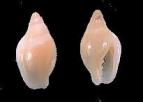
Austroginella tasmanica Tenison-Woods, 1876
Diagnosis: The shell is high-spired for the family, and rounded. The whorls are rounded. A callus covers the ventral side of the last whorl. The columella is concave with plaits occupying its bottom half. The colour is yellow with a white subsutural band.
Size: 7mm.
Range: Central New South Wales to Victoria, including Tasmania.

Mesoginella infelix Jousseaume, 1875
Diagnosis: The shell is egg-shaped. The spire is visible, but barely elevate. The last whorl is rounded, with the greatest width above the middle of the shell. The columella is nearly straight, with plaits occupying 1/4th of its length. The outer lip is straight. The colour is white.
Size: 8mm.
Range: Central New South Wales to Victoria, including Tasmania
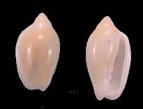
Mesoginella translucida (Sowerby, 1846)
Diagnosis: The shell is thick. The spire is moderately elevate, with straight sides. The columella is straight, with plaits occupying half its length. The outer lip is straight and more thickened in the middle than on both ends. The aperture is narrow. The colour is yellow and translucent in fresh specimens, with a darker yellow subsutural band.
Size: 6mm.
Range: Southern Queensland to South Australia.
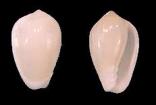
Mesoginella turbinata (Sowerby, 1846)
Diagnosis: The shell is thick. The spire is moderately elevate, with straight sides, forming an angle of about 90o. The sutures are visible, but not impressed. The sculpture consists of a single row of longitudinal knobs on the body whorl just below the suture. The columella is nearly straight, plaits occupying one third of its length. The outer lip is straight, slightly thicker in the middle than at both ends. The colour is white, in fresh specimens the colour is off-white with a very faint yellow band visible just below the sutures.
Size: 10mm.
Range: Central New South Wales to southern Western Australia, including Tasmania.
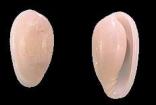
Ovaginella ovulum (Sowerby, 1846)
Diagnosis: The shell is egg-shaped, not unlike some species of the tropical family Ovulidae. The spire and the apex are completely enveloped by the last whorl, which is evenly rounded. The columella is convex, with plaits occupying only 1/5th of its length. The outer lip is relatively thin and curved. The anterior sinus is almost nonexistent. The colour is white.
Size: 9mm.
Range: Central New South Wales to Victoria.
Mollusca Obituary, Ruth Dixon Turner
The following obituary was written by George Buckley.
Ruth Dixon Turner died on Sunday, April 30, 2000. She held the Alexander Agassiz Professorship at Harvard University and was a Curator of Malacology in the University's Museum of Comparative Zoology where she also served as co-editor of the scientific journal "Johnsonia". She graduated from Bridgewater State College, earned a Masters degree at Cornell University and a PhD at Harvard/Radcliffe under the direction of Dr. William J. Clench who brought her to Harvard from the Clapp Labs in Duxbury.
Turner who had begun her scientific and teaching career in a one room schoolhouse in Vermont went on to become the world's expert on Teredos, bivalved molluscs called shipworms. These marine borers cause widespread destruction by eating wood in the ocean environment, destroying piers, docks and wooden boats. She became known affectionately as "Lady Wormwood" for her work in this field. It was she that explained why there was little wood left on the sunken liner Titanic when fellow scientist Robert Ballard discovered it.
During her career, which spanned some five decades, Dr. Turner kept laboratories in La Parguera in cooperation with the University of Puerto Rico, Northeastern University's Marine Sciences Institute at Nahant, the Marine biological Laboratory at Woods Hole and at Harvard. Her work led to collaboration with the United Nations Food and Agriculture Organization, U.S. Navy Office of Oceanography that funded much of her research and the Woods Hole Oceanographic Institution where she became the first woman scientist to utilize the Deep Submergence Research Vehicle ALVIN to study the deep sea.
Over some two decades she participated in several dozen oceanographic expeditions. The Oceanographic Institution later named Turner a "Women Pioneer in Oceanography". She received many other honours including a number of honorary degrees. The venerable Boston Sea Rovers, an ocean education group of which she became an esteemed member named her " Diver of the Year" and in recognition of her accomplishments the U.S. Navy dedicated their book on "Biodegradation in the Sea" to Professor Turner. Other book dedications noted that she was a "Biologist par Excellence" and quoted her oft-repeated motto "know your animals". Dr. Turner's last major project was as a member of the scientific team that investigated the wreck of the "Central America"- a sunken steamer that contained millions in lost gold. It has been called the most scientifically studied shipwreck ever by a Federal judge.
A past President and beloved member of the Boston Malacological Club and the American Malacological Union, Dr.Turner provided leadership to these organizations and guidance to their members who study seashells and other molluscs. She was a Director of the Marine Ecology Project and a consultant to many organizations including the National Geographic Society and its programs on deep-sea vent systems. Lecturing widely, she shared her knowledge and love of the sea and its life. A dedicated teacher and skilled dissectionist and illustrator, Turner was a mentor to hundreds of students around the world. She trained people, opened doors for them and watched proudly as they started out on their own careers.
Dr. Turner leaves her sisters Winifred Garrity and Lina MacNeil. She is predeceased by her parents and her brothers Henry and Arthur and sisters Jessie, Mary and Frances. Contributions are being accepted to a Memorial Fund that has been established in her name at the Woods Hole Oceanographic Institution.
[George adds the following personal comments:]
As a teenager I began working for Ruth Turner and Bill Clench in the Mollusc Dept. at Harvard University's Museum of Comparative Zoology. Being the person with a car I became the "designated driver" so to say and ended up being in charge of field expeditions in the local area which led to many enjoyable afternoons and very early morning '"Minus tides" - the better to collect marine specimens as well as leading to muddy feet and a very messy car as all sorts of marine fauna and flora were brought back to Harvard. Ruth provided sage council on my winning high school science fair projects on "Radula the teeth of snails" and was duly proud of my achievements. The job grew in importance as I had the prime responsibility on many occasions of getting Ruth " to the sub on time" at Woods Hole. As I entered college the collecting went further afield with trips to the Everglades, the Altamaha River and Puerto Rico. Ruth was always there to provide guidance, support, and training in dissections whatever was needed. I particularly enjoyed going to conferences and seminars with Ruth and observing the great good will shown towards her. She truly loved what she did and greatly enjoyed interacting with people and people loved her. I taught a course on Ocean Environments with her for many years at the Harvard University Extension School and even after she retired and I kept teaching the course she would accompany us on our field trips - "Cape Cod Expeditions" as they are known-well into her eighties much to the benefit and enjoyment of my students. Ruth will be missed by legions of students.
|













